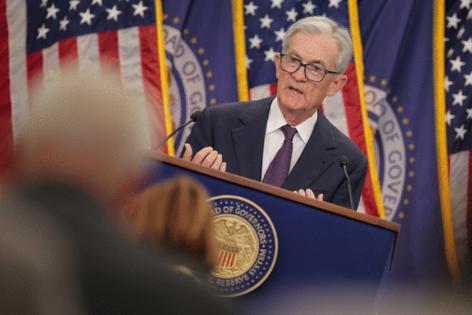Fed cuts rates quarter point, signals labor market concerns
Published in Business News
Federal Reserve officials lowered their benchmark interest rate by a quarter percentage point and penciled in two more reductions this year following months of intense pressure from the White House to slash borrowing costs.
In their post-meeting statement, policymakers pointed to growing signs of weakness in the labor market to justify their first rate cut since December, but also acknowledged that inflation has “moved up and remains somewhat elevated.”
Officials said the unemployment rate had “edged up but remains low,” adding that “downside risks to employment have risen.”
The Federal Open Market Committee voted 11-1 on Wednesday to cut the target range for the federal funds rate to 4%-4.25%, after holding rates steady for five straight meetings this year.
Only one official, the newly-sworn-in Stephen Miran, voted against the decision. He favored a larger, half-point cut. Governors Michelle Bowman and Christopher Waller, who dissented in July in favor of a cut, agreed with the quarter-point move.
Treasuries rallied and the dollar extended its drop. The S&P 500 reversed an initial jump after the decision.
The cut was widely expected amid signs the central bank’s concerns are shifting toward employment and away from inflation, following a sharp slowdown in hiring over the last several months.
Policymakers also updated their economic projections at this meeting and now see two additional quarter-point cuts this year. That’s one more than projected in June. They foresee one quarter-point cut in 2026 and one in 2027.
One Fed official projected the policy rate would drop by another one and a quarter percentage point by December.
In their economic forecast, policymakers slightly upgraded their median outlook for growth in 2026. They also forecast modestly higher inflation next year.
Jackson Hole
Powell signaled the Fed could lower rates this month in a speech at the central bank’s annual Jackson Hole conference in August. After detailing the conflicting developments on each side of the Fed’s dual mandate, Powell said that “the baseline outlook and the shifting balance of risks may warrant adjusting our policy stance.”
A report released earlier this month showed hiring continued to slow in August, and the unemployment rate rose to 4.3%, the highest in almost four years.
But inflation has also accelerated in the past few months as companies increasingly passed tariffs on to consumers. The Fed’s preferred gauge of prices rose 2.6% in the year through July, and analysts expect the August reading due later this month to show another uptick, according to a Bloomberg survey.
While the impact of import duties has been more muted than many expected, some Fed officials remain concerned the tariffs haven’t fully worked through the economy, and could still generate a persistent impact on inflation, rather than represent a one-off adjustment. That has contributed to the central bank’s cautious approach toward rate cuts this year.
Others like Waller and Bowman, both of whom were appointed by President Donald Trump in his first term, see the likely impact as temporary and have argued the Fed should lower rates more quickly to a neutral level, where they are neither weighing on nor stimulating the economy.
Political pressure
The rate cut also comes amid extraordinary political pressure for lower borrowing costs. Trump has repeatedly demanded drastic rate reductions, and is currently attempting to fire a Fed Governor, Lisa Cook. His newest appointee, Miran, was sworn in Tuesday morning, just in time to join the meeting.
Miran, who has taken unpaid leave from his post as chair of the White House Council of Economic Advisers, filled a seat that is set to expire in January. He could stay longer if no other nominee is confirmed to fill the seat for a full term.
(With assistance from Kristine Aquino and Sophie Caronello.)
©2025 Bloomberg L.P. Visit bloomberg.com. Distributed by Tribune Content Agency, LLC.












Comments